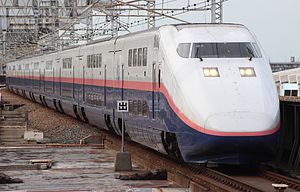E1 series
| E1 series | |
|---|---|

E1 series train set M5, September 2012
|
|
| In service | July 1994 – September 2012 |
| Manufacturer | Hitachi, Kawasaki Heavy Industries |
| Family name | Max |
| Constructed | 1994–1995 |
| Refurbishment | 2003–2006 |
| Scrapped | 2012 |
| Number built | 72 vehicles (6 sets) |
| Number in service | None |
| Number scrapped | 48 vehicles (4 sets) |
| Formation | 12 cars per trainset |
| Fleet numbers | M1–M6 |
| Capacity | 1,235 |
| Operator(s) | JR East |
| Depot(s) | Sendai, Niigata |
| Line(s) served | Tohoku Shinkansen, Joetsu Shinkansen |
| Specifications | |
| Car body construction | Steel |
| Car length | End cars: 26,050 mm (85 ft 6 in), Intermediate cars: 25,000 mm (82 ft 0 in) |
| Width | 3,430 mm (11 ft 3 in) |
| Height | 4,493 mm (14 ft 9 in) |
| Doors | Two per side |
| Maximum speed | 240 km/h (150 mph) |
| Traction system | (AC) MT204 (24 x 410 kW) |
| Power output | 9.84 MW (13,200 hp) |
| Acceleration | 1.6 km/(h·s) (0.99 mph/s) |
| Electric system(s) | 25 kV AC, 50 Hz, overhead catenary |
| Current collection method | PS201 pantograph |
| Bogies | DT205 (motored), TR7003 (trailer) |
| Safety system(s) | ATC-2, DS-ATC |
| Multiple working | None |
| Track gauge | 1,435 mm (4 ft 8 1⁄2 in) |
The E1 series (E1系?) was a high-speed Shinkansen train type operated by East Japan Railway Company (JR East) in Japan from July 1994 until September 2012. They were the first double-deck trains built for Japan's Shinkansen. They were generally, along with their fellow double-deck class the E4 series, known by the marketing name "Max" (Multi-Amenity eXpress). The fleet was withdrawn from regular service on 28 September 2012.
Originally intended to be classified as 600 series, the E1 series trains were introduced specifically to relieve overcrowding on services used by commuters on the Tohoku Shinkansen and Joetsu Shinkansen.
E1 series sets were used on the following services.
The fleet of 12-car sets, numbered M1 to M6, were formed as follows, with car 1 at the Tokyo end.
Cars 6 and 10 were each equipped with a PS201 scissors-type pantograph.
(Sources:)
The E1 series was the first revenue-earning shinkansen to feature 3+3 abreast seating in standard class for increased seating capacity. The upper deck saloons of non-reserved cars 1 to 4 were arranged 3+3 with no individual armrests, and did not recline. The lower decks of these cars, and the reserved-seating saloons in cars 5 to 12 had regular 2+3 seating. The Green car saloons on the upper decks of cars 9 to 11 had 2+2 seating. The trains had a total seating capacity of 1,235 passengers.
Green car upper deck, January 2002
Standard class reserved car upper deck, January 2002
Standard class non-reserved car upper deck with non-reclining 3+3 seating, January 2002
Standard class reserved car lower deck, January 2002
Standard class non-reserved car lower deck, January 2002
Car 11 Green car upper deck, October 2011
Car 11 standard class reserved car lower deck, October 2011
The first E1 series set, M1, was delivered to Sendai Depot on 3 March 1994, sporting "DDS E1" logos (DDS standing for double-deck shinkansen). ローカル鉄道途中下車の旅 The first two E1 series sets delivered entered revenue-earning service on the Tohoku Shinkansen on 15 July 1994, with the original "DDS" logos replaced by "Max" logos. The original livery was "sky grey" on the upper body side and "silver grey" on the lower body side, separated by a "peacock green" stripe.
...
Wikipedia
